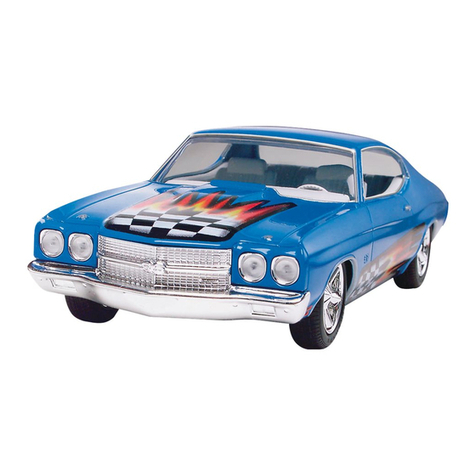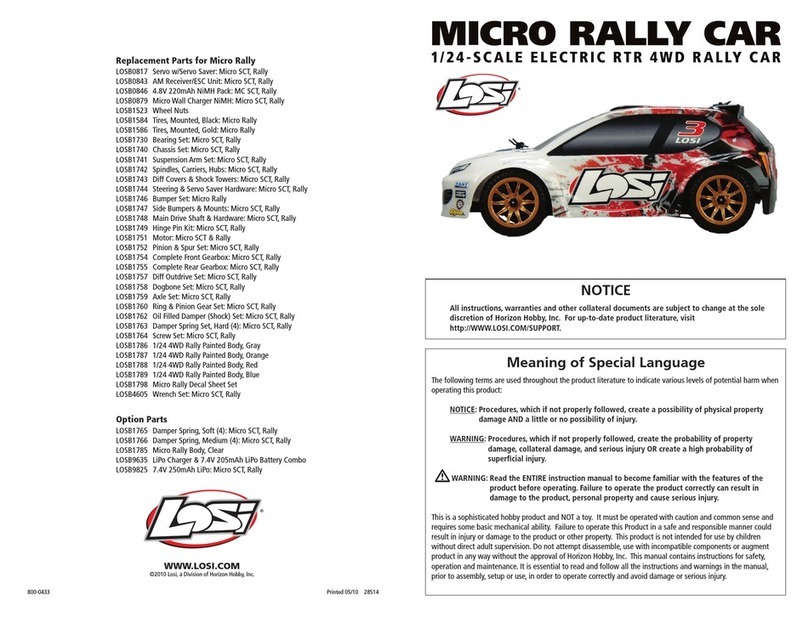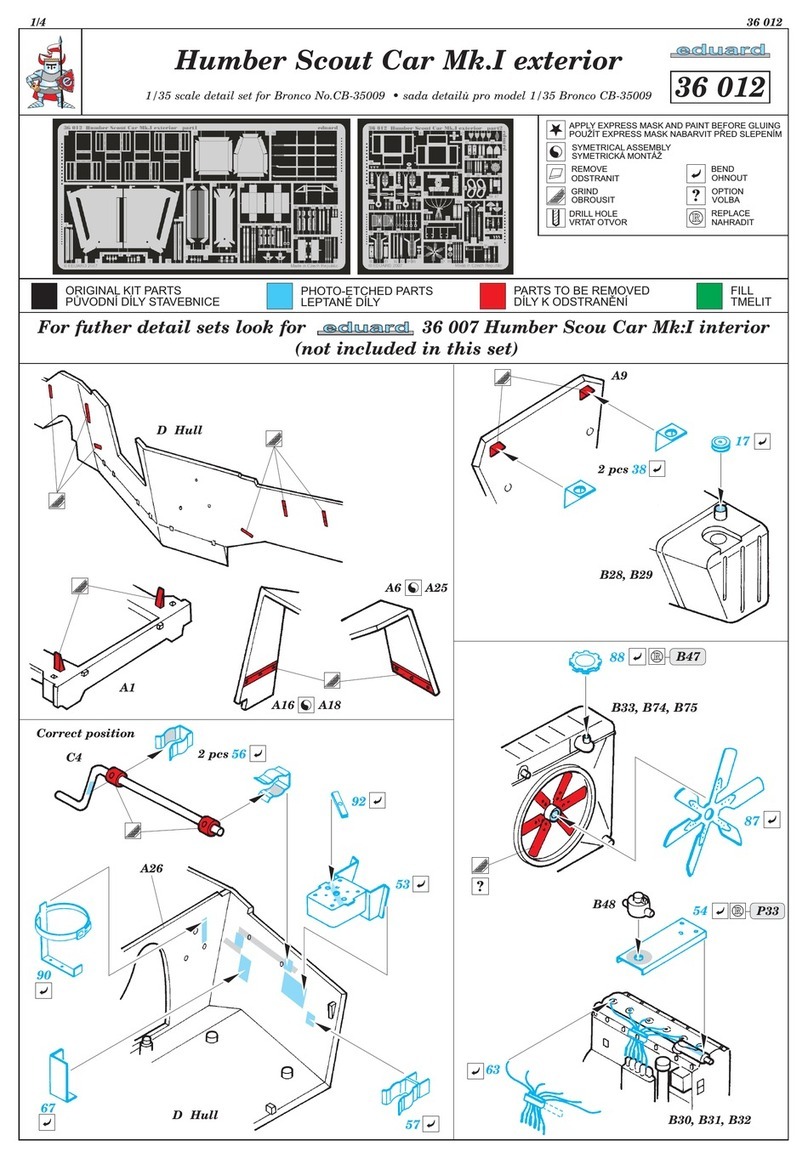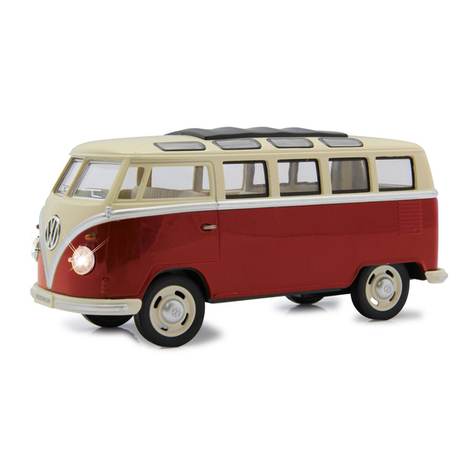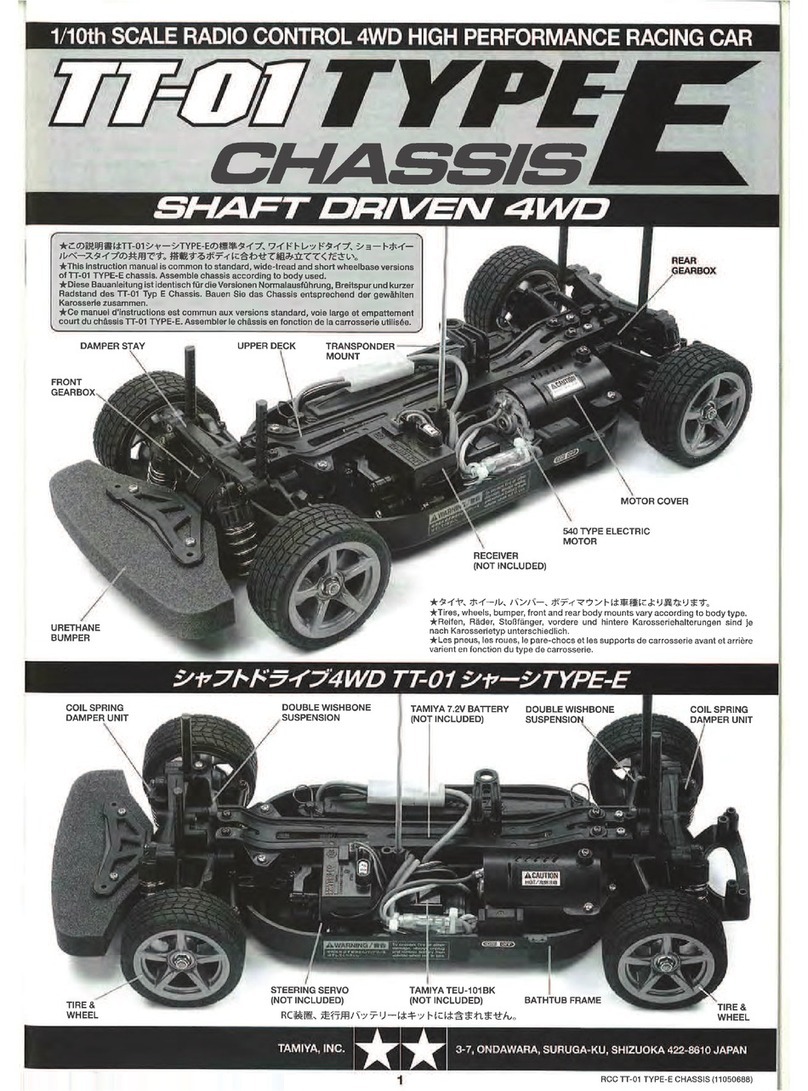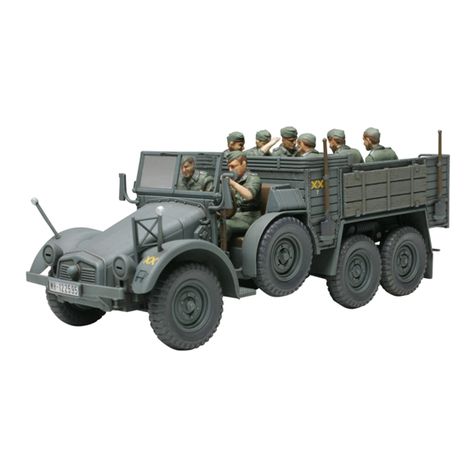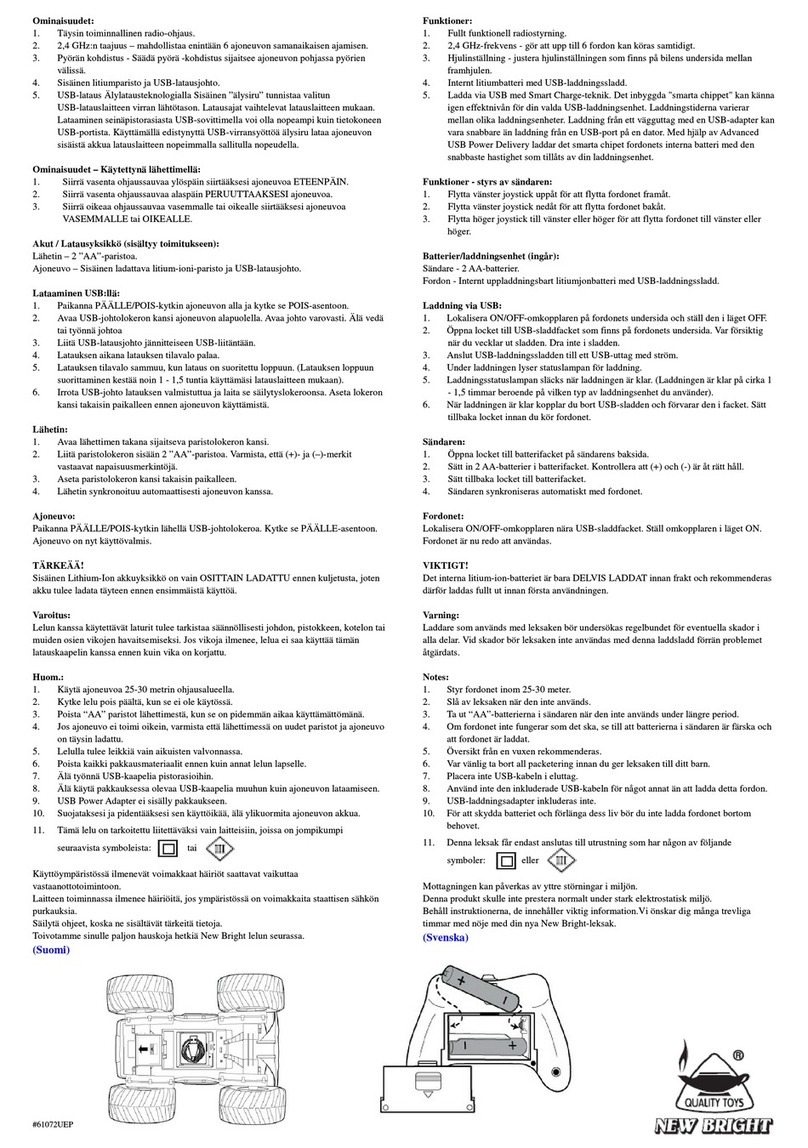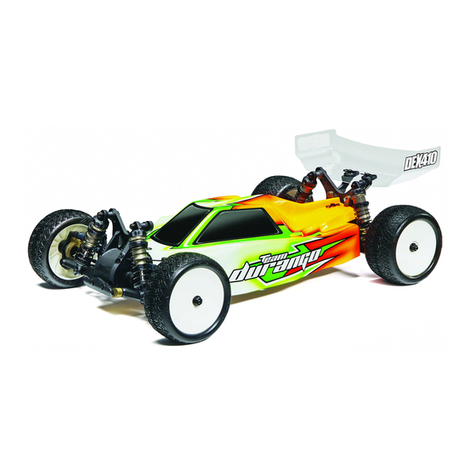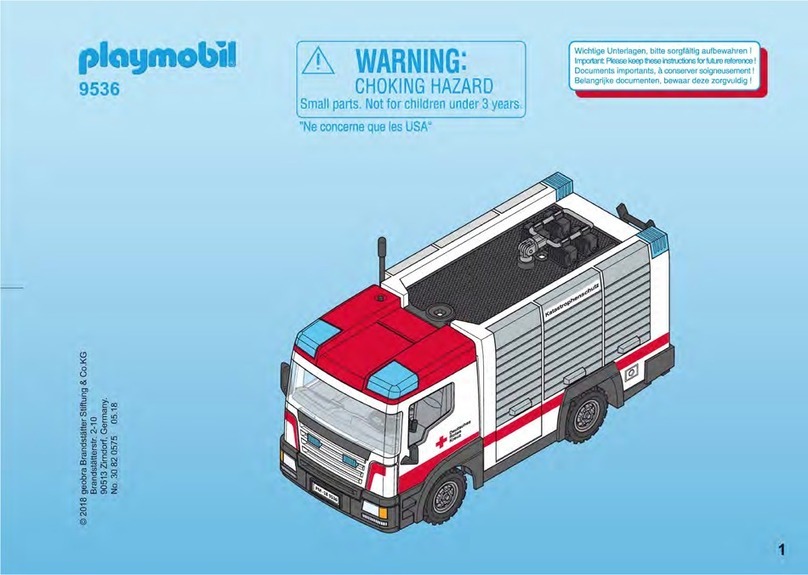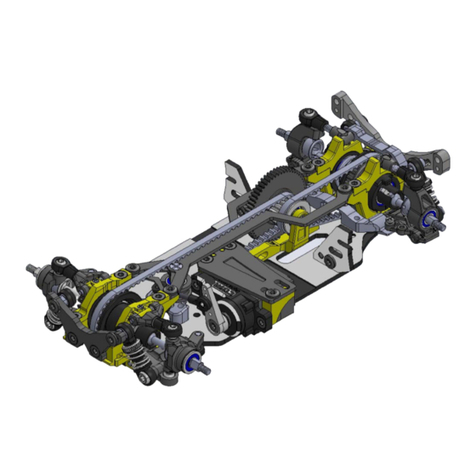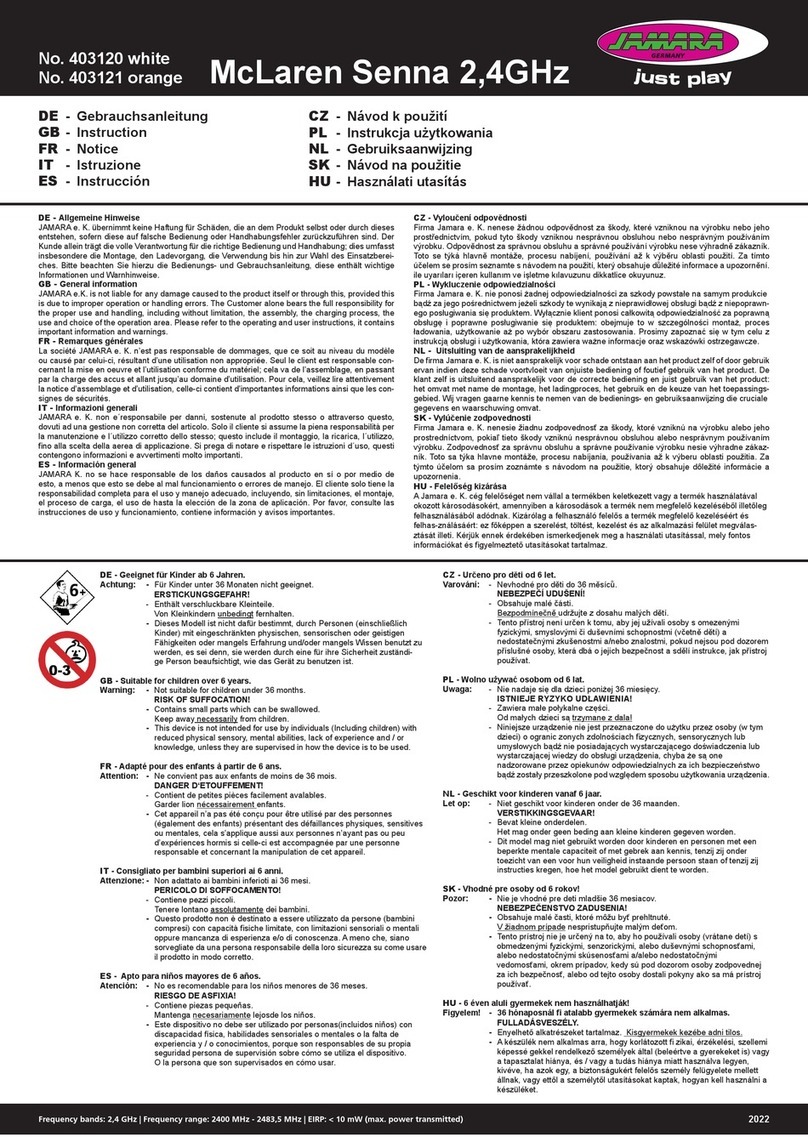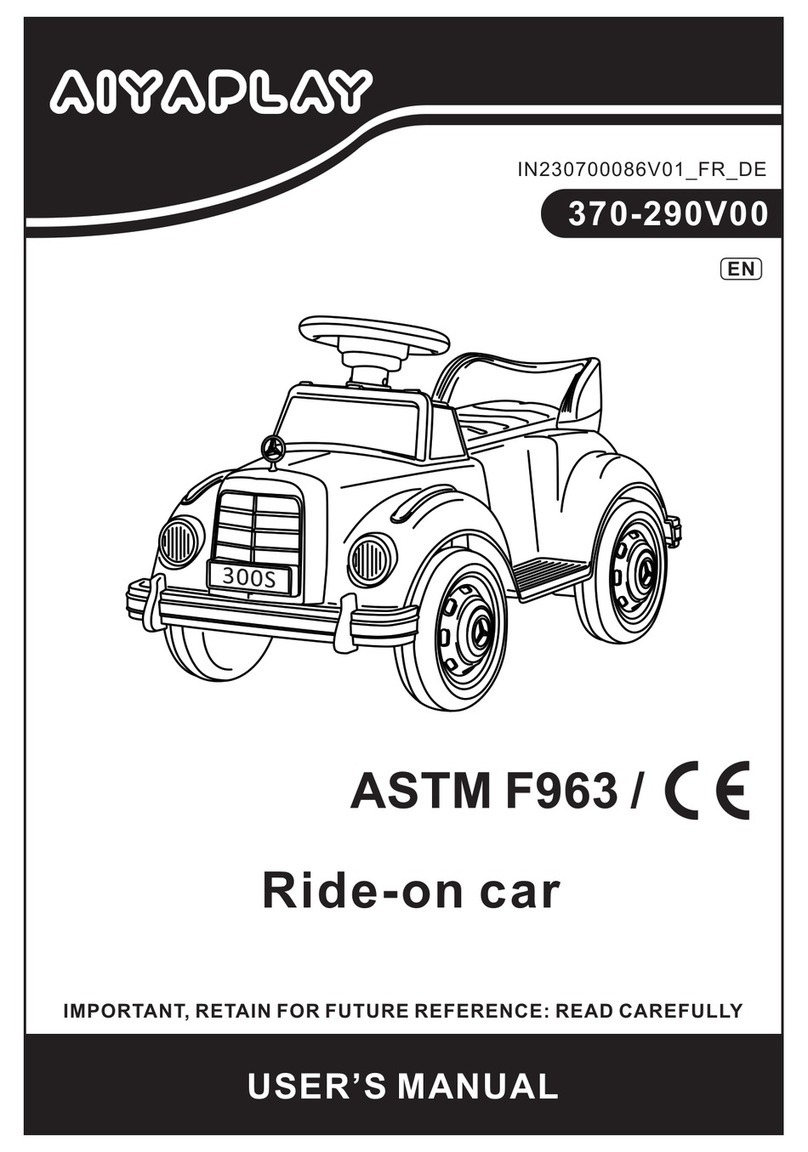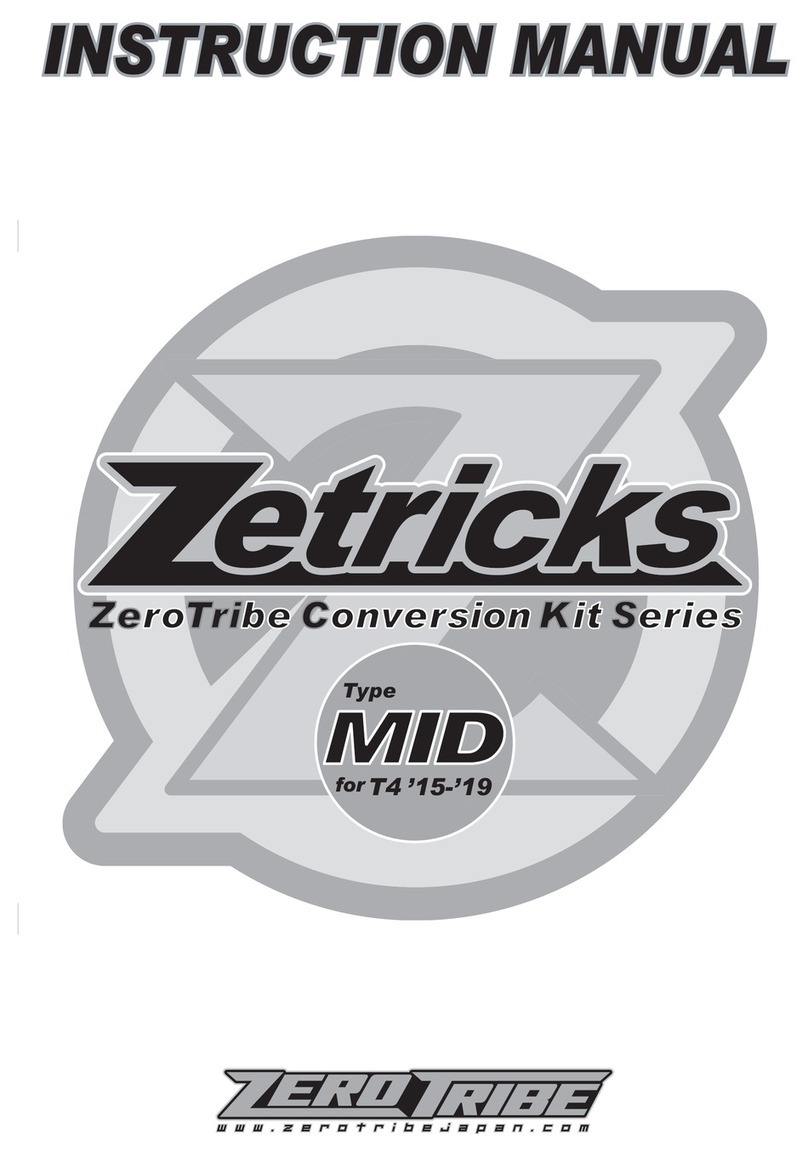ROBBE Subaru Impreza WRC User manual

Betriebsanleitung
Operating instructions
Notice d´utilisation
1:10 On road cars
Subaru Impreza WRC
No. 2022
BMW M 3 GTR
No. 2023
Porsche 911 Turbo
No. 2021

2
Betriebsanleitung, Operating instructions, Notice d’utilisation
1:10 On road Cars

3
Betriebsanleitung, Operating instructions, Notice d’utilisation
1:10 On road Cars
4 WD Chassis mit Tuningteilen aus dem Zubehörprogramm
4-WD chassis with upgrade parts from the accessory range
Le châssis quatre roues motrices avec les accessoires de compétition
proposés avec la gamme des accessoires

Betriebsanleitung, Operating instructions, Notice d’utilisation
1:10 On road Cars
4
Technische Daten
Subaru BMW Porsche
Länge: ca. 430 mm ca. 430 mm ca. 430 mm
Breite: ca. 200 mm ca. 200 mm ca. 200 mm
Radstand: ca. 260 mm ca. 260 mm ca. 260 mm
Höhe: ca. 135 mm ca. 115 mm ca. 125 mm
Gewicht: ca. 1450 g ca. 1450 g ca. 1450 g
Verehrter Kunde,
Sie haben sich für ein vormontiertes Modellfahrzeug für
Elektroantrieb aus dem Hause robbe Modellsport ent-
schieden.
Um Ihnen den sicheren Betrieb dieses Modells zu
erleichtern, sollten Sie unbedingt die beiliegenden
Informationen vor der ersten Inbetriebnahme genau
durchlesen.
Alle Positionsangaben sind in Fahrtrichtung zu sehen.
Empfohlenes Zubehör:
Fernsteuerung Megatech T-2PHKA No. F2223
oder
Fernsteuerung Megatech T-2PL No. F2206
oder
Fernsteuerung Megatech T3PM No. F3014
oder
Fernsteuerung Megatech T3PK(B) No. F3016
oder
Fernsteuerung FF-3 (T3VCS) No. F3030
Senderakku je nach
Fernsteuersender
Senderladekabel No. F1415
Empf. Zubehör „High Performance“:
Fahrakku 6NC C2,4k TAM No. 4613
Fahrtregler rookie Sport WP No. 8390 oder
Fahrtregler rookie Turbo WP No. 8419
Tuning-E-Motor
HIGH PERFORMANCE 13x3 No. 4492
Specification
Subaru BMW Porsche
Length: ap. 430 mm ap. 430 mm ap. 430 mm
Width: ap. 200 mm ap. 200 mm ap. 200 mm
Wheelbase: ap. 260 mm ap. 260 mm ap. 260 mm
Height: ap. 135 mm ap. 115 mm ap. 125 mm
Weight: ap. 1450 g ap. 1450 g ap. 1450 g
Dear customer,
Congratulations on your choice of a factory-assembled
electric-powered model car from the robbe Modellsport
range.
To make it easier for you to operate this model safely and
reliably please be sure to read the information sheets
included in the pack before operating the car for the first
time.
All directions (e.g. „right-hand“) are as seen from the
rear of the car looking forward.
Recommended accessories:
Megatech T-2PHKA radio control system No. F2223
or
Megatech T-2PL radio control system No. F2206
or
Megatech T3PM radio control system No. F3014
or
Megatech T3PK(B) radio control system No. F3016
or
FF-3 (T3VCS) radio control system No. F3030
Transmitter battery To suit
transmitter
Transmitter charge lead No. F1415
Recommended „High Performance“ accessories:
Drive battery, 6NC C2.4k TAM No. 4613
Speed controller, rookie Sport WP No. 8390 or
Speed controller, rookie Turbo WP No. 8419
Upgrade motor,
„High Performance“ 13x3 No. 4493
Caractéristiques techniques
Subaru BMW Porsche
longueur: ap. 430 mm ap. 430 mm ap. 430 mm
largeur: ap. 200 mm ap. 200 mm ap. 200 mm
empattem.: ap. 260 mm ap. 260 mm ap. 260 mm
hauteur: ap. 135 mm ap. 115 mm ap. 125 mm
poids: ap. 1450 g ap. 1450 g ap. 1450 g
Cher Client,
Vous avez choisi un modèle réduit d’auto prémonté pour
moteur électrique de la Sté robbe Modellsport.
Pour vous faciliter la maîtrise du véhicule, il est indispen-
sable de lire les feuilles d’information jointes avant la pre-
mière mise en œuvre.
Toutes les indications de position sont à considérer
dans le sens de déplacement du véhicule.
Accessoires recommandés:
ensemble de radiocommande
Megatech T-2PHKA réf. F2223
ou
ensemble de radiocommande
Megatech T-2PL réf. F2206
ou
ensemble de radiocommande
Megatech T3PM réf. F3014
ou
ensemble de radiocommande
Megatech T3PK(B) réf. F3016
ou
ensemble de radiocommande FF-3 (T3VCS) réf. F3030
accu de l'émetteur en fonction de l'émetteur
cordon de charge de l'émetteur réf. F1415
Accessoires haute performance recommandés:
accu d'alimentation du moteur 6 éléments
Cd-Ni C2,4k TAM réf. 4613
variateur de vitesse rookie Sport WP réf. 8390
ou variateur de vitesse rookie Turbo WP réf. 8419
moteur de compétition
„High Performance 13 x 3“ réf. 4492

Betriebsanleitung, Operating instructions, Notice d’utilisation
1:10 On road Cars
5
TAM-Gold-Buchse No. 4060
TAM-Gold-Stecker No. 4061
Empf. Zubehör „Maximum Performance“:
Fahrakku 6NiMH C3,3k TAM No. 4513
Fahrtregler MC800C No. F1242
Tuning-E-Motor
MAXIMUM PERFORMANCE 12x1 No. 4493
TAM-Gold-Buchse No. 4060
TAM-Gold-Stecker No. 4061
Empfohlene Ladetechnik:
Power Peak 400 No. 8428
oder
Power Peak Infinity LI Deutsch No. 8294LID
Bau- und Betriebsanleitung
Bei der Vorbereitung des Modells richten Sie sich bitte
nach dieser Anleitung.
Hinweise: Zur Vermeidung von Verletzungen ist besonde-
re Vorsicht im Umgang mit den erforderlichen
Werkzeugen und Bauteilen des Modells geboten.
Es empfiehlt sich, die Anleitung aufzuheben, um bei
Reparaturen und Ersatzteilbestellungen nachschlagen zu
können.
Die Bearbeitung der Karosserie ist auf den Seiten 18 - 23
beschrieben.
Eine Gesamtübersicht der Ersatzteile finden Sie auf den
Seiten 24 - 28.
Tuningteile finden Sie auf den Seiten 29 - 31.
TAM-Gold-socket No. 4060
TAM-Gold-plug No. 4061
Recommended „Maximum Performance“ accessories:
Drive battery, 6NiMH C3.3k TAM No. 4513
Speed controller, FUTABA MC800C No. F1242
Upgrade motor,
„Maximum Performance“ 12x1 No. 4493
TAM-Gold-socket No. 4060
TAM-Gold-plug No. 4061
Recommended battery chargers:
Power Peak 400 No. 8428
or
Power Peak Infinity LI No. 8294LI
Assembly and operating instructions
Please follow these instructions when preparing the
model.
Note: to avoid injury please take special care when hand-
ling the tools and model components.
We recommend that you keep these instructions in a safe
place so that you can refer back to them for repairs and
when ordering replacement parts.
Please see pages 18 - 23 for details of finishing the body-
work.
See pages 24 - 28 for an overall view of the available
replacement parts.
There is a list of available upgrade components on pages
29 - 31.
Fiche femelle plaquée d’or TAM réf. 4060
Fiche mâle plaquée d’or TAM réf. 4061
Accessoires performance maximale recommandés:
accu du moteur 6NiMH C3,3k TAM réf. 4513
variateur de vitesse FUTABA MC800C réf. F1242
Moteur de compétition
„Maximum Performance 12 x 1“ réf. 4493
Fiche femelle plaquée d’or TAM- réf. 4060
Fiche mâle plaquée d’or TAM- réf. 4061
Technologie de charge recommandée:
Power Peak 400 réf. 8428
ou
Power Peak Infinity LI réf. 8294LI
Notice d’assemblage et de mise en service
Pour la préparation du modèle, suivre les instructions pré-
sentées par cette notice.
À noter : pour éviter toute blessure, il est recommandé
d’être particulièrement prudent en ce qui concerne la
manipulation des outils nécessaires et des composants
du modèle.
Il est conseillé de conserver les différentes notices du
modèle et de ses composants afin de pouvoir les consul-
ter en cas de réparation et de commande de pièces de
rechange.
Le traitement de la carrosserie est décrit sur les pages 18
à 23.
Un récapitulatif des pièces de rechange est présenté sur
les pages 24 à 28.
Les accessoires de compétition sont présentés sur les
pages 29 à 31.

Betriebsanleitung, Operating instructions, Notice d’utilisation
1:10 On road Cars
6
12
34

Betriebsanleitung, Operating instructions, Notice d’utilisation
1:10 On road Cars
7
Hinweis zur Motorisierung
Das Modell kann mit verschiedenen Motoren der
Baugröße 540 und verschiedenen Reglern ausgerüstet
werden. Beschrieben und gezeigt sind der Einbau des
Motors HIGH PERFORMANCE 13x3 mit Fahrtregler roo-
kie Sport WP.
Beim Einbau anderer Motoren in gleicher Weise vorgehen.
Hinweis: Ist ein Regler ohne Steckverbindung zum Motor
vorgesehen, die Motorkabel direkt anlöten.
Ebenso eine eventuell erforderliche Steckverbindung für
den Akku anbringen.
Bei allen Arbeiten am Fahrtregler die Anleitung beachten,
die dem Gerät beiliegt.
Bild 1
-Die Räder auf die Sechskantmitnehmer aufstecken und
mit den M 4-Radmuttern festsetzen.
Bilder 2 und 3
-Motor einsetzen. Schrauben mit Unterlegscheiben ein-
drehen, nicht festziehen.
Bild 4
- Madenschraube mit Loctite versehen.
-Motorritzel mit Madenschraube versehen und auf die
Motorwelle schieben.
Note: power system
The model can be fitted with various 540-size motors, and
various speed controllers. These instructions describe
and illustrate the installation of the HIGH PERFORMAN-
CE 13x3 motor and the rookie Sport WP speed control-
ler.
The same procedure can be applied if you install a diffe-
rent motor.
Note: If your speed controller does not feature a connec-
tor for the motor, solder the wires directly to the motor ter-
minals.
If necessary, attach a suitable connector to the speed
controller to match the drive battery.
Be sure to read the instructions supplied with the speed
controller before installing or adjusting the unit.
Fig. 1
- Fit the wheels on the hexagon drivers and tighten the
M4 wheel nuts to secure them.
Figs. 2 and 3
- Place the motor in position. Fit the washers on the retai-
ning screws, and install the motor using the screws; do
not tighten them at this stage.
Fig. 4
- Apply a drop of Loctite (thread-lock fluid) to the grub-
screw.
- Fit the grubscrew in the motor pinion, and slip the pini-
on on the motor shaft.
Indications concernant la motorisation
Le modèle peut être équipé de moteurs différents de la
catégorie des 540 et de divers variateurs. Cette notice
décrit et présente la mise en place du moteur HIGH PER-
FORMANCE 13x3 associé au variateur rookie Sport WP.
Pour la mise en place d'autres moteurs, procéder de la
même manière.
À noter : s'il est prévu d'installer un variateur sans
connecteur à destination du moteur, souder directement
les brins du cordon du moteur.
Aménager également la connexion indispensable pour
l'accu d'alimentation du moteur.
Pour tous les travaux concernant le variateur, tenir comp-
te des instructions de la notice qui l'accompagne
Fig. 1
- Planter les roues sur l'entraîneur six pans et les y fixer
avec les écrous de roue M 4.
Fig. 2 et 3
- Mettre le moteur en place Mettre les vis en place avec
les rondelles sans serrer les vis pour l'instant.
Fig. 4
- Munir la vis sans tête de Loctite.
- Installer la vis sans tête dans le pignon du moteur et le
glisser sur l'arbre du moteur.

Betriebsanleitung, Operating instructions, Notice d’utilisation
1:10 On road Cars
8
8
56
7

9
Bild 5
- Ritzel so justieren, dass es mit dem Zahnrad über die
volle Zahnbreite in Eingriff kommt und Madenschraube
über der Abflachung der Motorwelle festziehen.
Bild 6
- Zum genauen Einstellen des Zahnflankenspiels einen
Papierstreifen zwischen Zahnrad und Ritzel hindurch-
laufen lassen. Motor so andrücken, dass die Zahnräder
miteinander kämmen ohne zu klemmen.
- Motorbefestigungsschrauben anziehen.
Bild 7
- Regler und Empfänger mit Doppelklebebandstreifen auf
der RC-Platte befestigen
Bild 8
- Servohebelschraube lösen, Steuerscheibe bzw.
Kreuzhebel abnehmen. Anschließend das Servo mit
der Fernsteuerung in Neutralstellung bringen.
- Servo mit Gummitüllen bzw. Unterlagen versehen.
- Die Servohalter am Lenkservo verschrauben.
Fig. 5
- Position the pinion so that it meshes with the main gear
over the full width of the teeth. Rotate the pinion so that
the grubscrew is over the machined flat in the motor
shaft, then tighten it fully.
Fig. 6
- Feed a strip of paper between the pinion and the main
gear to set the correct meshing clearance. Press the
motor against the main gear so that the paper is squee-
zed between the gear teeth. This provides the correct
clearance when the paper is removed.
- Tighten the motor retaining screws.
Fig. 7
-Attach the speed controller and receiver to the RC plate
using strips of double-sided foam tape.
Fig. 8
-Undo the servo output screw and remove the standard
output disc or cruciform output lever. Set the servo to
centre from the transmitter.
- Press the rubber grommets and bushes into the servo
mounting lugs.
- Screw the servo mounts to the steering servo.
Fig. 5
- Ajuster le pignon de telle sorte qu'il s'engrène avec
toute la largeur des dents dans la roue dentée et serrer
la vis sans tête sur le chanfrein de l'arbre du moteur.
Fig. 6
- Pour régler avec précision le jeu à l'engrènement, faire
passer un ruban de papier entre la roue dentée et le
pignon. Pousser le moteur de telle sorte que l'engrena-
ge prenne parfaitement sans coincer toutefois.
- Serrer les vis de fixation du moteur.
Fig. 7
- Fixer le variateur et le récepteur avec des morceaux de
ruban adhésif double face sur la platine de l'ensemble
de réception.
Fig. 8
- Desserrer et retirer la vis de palonnier du servo, retirer
le palonnier circulaire ou le palonnier en croix du servo.
Amener ensuite le servo au neutre à l'aide de l'en-
semble de radiocommande.
- Munir le servo des passe-fils ou de cales.
- Visser les éléments du support-servo au servo de direc-
tion.
Betriebsanleitung, Operating instructions, Notice d’utilisation
1:10 On road Cars

Betriebsanleitung, Operating instructions, Notice d’utilisation
1:10 On road Cars
9
10
10
11 12

11
Bild 9
- Servo einsetzen. Servohalter mit den Senk- und
Linsenkopfschrauben am Chassis montieren.
Bild 10
- Die Litzenantenne des Empfängers abwickeln und in das
Antennenröhrchen einfädeln.
- Das Antennenröhrchen in den Antennenfuß einsetzen.
Bilder 11 und 12
-Lenkservo und Regler am Empfänger anschließen.
- Motor am Regler anschließen.
- Zum Einbau des geladenen Fahrakkus die Splinte am
Akkufach lösen und den Kunststoffhalter wegziehen.
- Den Fahrkku einschieben.
-Den Akku mit dem eingesetzten Halter und den
Splinten sichern.
Fig. 9
- Install the servo. Fix the servo mounts to the chassis
using the countersunk screws and pan-head screws
supplied.
Fig. 10
- Unwind the flexible wire aerial attached to the receiver
and slip it into the aerial sleeve.
- Push the aerial sleeve into the aerial base.
Figs. 11 and 12
-Connect the steering servo and the speed controller to
the receiver.
-Connect the motor to the speed controller.
- To install the drive battery you have to remove the split
pins in the battery compartment and lift off the plastic
holder.
-Slide the fully-charged drive battery into place.
- Re-fit the holder and the split pins to retain the battery.
Fig. 9
- Mettre le servo en place. Monter le support-servo au
châssis avec les vis à tête fraisée et les vis à tête bom-
bée.
Fig. 10
- Développer l'antenne souple du récepteur et l'enfiler
dans le tube d'antenne.
- Planter le tube d'antenne dans le pied de l'antenne.
Fig. 11 et 12
-Raccorder le servo de direction et le variateur au récep-
teur.
- Raccorder le moteur au variateur.
-Pour mettre les accus chargés d'alimentation du
moteur en place, défaire la goupille du logement de
l'alimentation et extraire le support en plastique.
- Glisser l'accu d'alimentation du moteur en place.
- Fixer l'accu en mettant le support en plastique en place
et en fixant avec les goupilles.
Betriebsanleitung, Operating instructions, Notice d’utilisation
1:10 On road Cars

Betriebsanleitung, Operating instructions, Notice d’utilisation
1:10 On road Cars
13
15
12
16
14
50 mm
“A”
“B”
“X”

13
Betriebsanleitung, Operating instructions, Notice d’utilisation
1:10 On road Cars
Bild 13
- Alle Kabel mit Kabelbindern oder Spiralschlauch so
zusammenfassen, dass sie sich nicht in drehenden Teilen
verheddern können.
Bild 14
-Die zwei Kugelgelenke auf die M 3 Gewindestange auf-
drehen. Das so gefertigte Lenkgestänge auf eine Länge
von ca. 50 mm einstellen.
- Hinweis: Dem Montagekasten liegen Servohebel mit
verschiedenen Feinverzahnungen bei. Die Hebel für
Futaba Servos sind mit einem “F” gekennzeichnet.
-Den Kugelkopf für die Lenkung in den einarmigen
Servohebel eindrehen.
- Zweiten Kugelkopf in die mittlere Bohrung des bereits
montierten Lenkhebels eindrehen.
Bilder 15 und 16
- Sender einschalten.
- Die Empfangsanlage durch Anschließen des Fahrakkus
einschalten.
-Lenkservo in Neutralstellung bringen.
- Ausschalten in umgekehrter Reihenfolge.
- Vorbereiteten Servohebel auf das Lenkgestänge auf-
drücken.
- Zweites Kugelgelenk auf den Kugelkopf des Servo-
Savers aufdrücken.
- Hebel auf das Servo stecken und mit der
Servohebelschraube sichern.
Fig. 13
- Bundle together all the cables using cable ties or spiral
tubing in such a way that they cannot possibly foul or
get caught in the rotating parts.
Fig. 14
- Screw the two ball-links onto the M3 threaded rod to
make the steering pushrod. Set the pushrod to a length
of about 50 mm.
- Note: the kit is supplied with servo output arms fea-
turing different spline patterns. If you are using a Futaba
servo, use the arm marked with a letter “F”.
- Screw the ball-end bolt for the steering system into a
hole in the single-arm servo output lever.
-Screw the second ball-end bolt into the centre hole of
the steering arm, which is already installed.
Figs. 15 and 16
- Switch on the transmitter.
-Switch on the receiving system by connecting the drive
battery to the speed controller.
- Set the steering servo to neutral (centre).
- Switch off in the reverse order (transmitter last).
-Press the prepared servo output arm onto the steering
pushrod.
-Press the second ball-link onto the ball-end bolt on the
servo-saver.
-Fit the output arm on the servo, and tighten the output
screw to secure it.
Fig. 13
- Rassembler tous les cordons à l'aide de ligatures ou
d'un flexible hélicoïdal de sorte qu'ils ne puissent entrer
en contact avec des éléments mobiles dans l'auto.
Fig. 14
- Monter les deux articulations sphériques sur la tige
filetée M 3. Régler la longueur de la tringle de direction
sur une longueur approximative de 50 mm.
-À noter : La boîte de construction fournit plusieurs
palonniers de servo présentant une denture fine diver-
se. Les palonniers destinés aux servos de marque
Futaba sont munis d'un repère “F”.
- Monter le pivot sphérique de la direction sur le palon-
nier de servo à un bras.
- Monter le second pivot sphérique dans l'alésage du
milieu du palonnier de direction déjà installé.
Fig. 15 et 16
-Mettre l'émetteur en marche.
- Mettre l'ensemble de réception en marche en raccor-
dant l'accu d'alimentation du moteur.
- Amener le servo de direction en position neutre.
-Pour couper l'ensemble de réception procéder dans
l’ordre inverse.
- Planter le palonnier de servo préparé sur la tringle de
direction.
- Planter la seconde articulation sphérique sur le pivot
sphérique du sauve-servo.
-Planter le palonnier sur le servo et l'y fixer avec la vis de
fixation du palonnier de servo.

17 18
19 20
14
Betriebsanleitung, Operating instructions, Notice d’utilisation
1:10 On road Cars

Betriebsanleitung, Operating instructions, Notice d’utilisation
1:10 On road Cars
15
Bilder 16 und 17, die Lenkung
- Bei Betätigen des Lenkrads “A“ nach rechts (links) müs-
sen die Räder nach rechts (links) einschlagen.
- Ist dies nicht der Fall, Servo-Reverse-Schalter betäti-
gen.
Bilder 16 und 18, Gas (Vor- und Rückwärtsfahrt)
Regler gemäß beiliegender Anleitung aktivieren.
Bei Vorwärtsfahrt muß die rote LED gleichmäßg leuchten.
Blinkt die rote LED, die Motor-Anschlußkabel gegenein-
ander vertauschen.
Befindet sich der Gashebel “B” in Vorwärtsstellung “X” ,
muß der Fahrtregler im Vorwärtsbetrieb sein (Die LED darf
nicht blinken). Andernfalls muß im Sender Servo-Reverse
für den Gaskanal betätigt werden.
Damit ist das Fahrzeug betriebsbereit.
Fahrwerkseinstellungen:
Hinweis: Das Chassis ist werksseitig grundeingestellt.
Wenn Sie sich mit den Fahreigenschaften vertraut
gemacht haben, können Sie das Modell durch
Veränderungen an den Fahrwerkseinstellungen auf Ihre
Bedürfnisse abstimmen.
Bilder 19 und 20, Einstellen der Stoßdämpfer:
- Beachten Sie, daß alle folgenden Einstellungen an bei-
den Seiten einer Achse durchgeführt werden müssen,
um den beschriebenen Effekt zu erzielen.
-Durch Links- oder Rechtsdrehen der Rändelmutter am
Stoßdämpferzylinder verändern Sie die Bodenfreiheit
des Modells, nicht die Federhärte. Die Einstellung der
Bodenfreiheit richtet sich nach der Beschaffenheit des
befahrenen Untergrundes und sollte immer möglichst
gering gehalten werden, ohne daß das Chassis beim
Durchfedern den Boden berührt.
-Die Federhärte können Sie durch den Austausch der
serienmäßigen Federn gegen die Tuningfedern
No.20170084 (Ø 1,3mm) oder No.20170085 (Ø 1,4mm)
verändern.
- Am einfachsten lässt sich die Federcharakteristik durch
einen geänderten Befestigungswinkel der
Fig. 16 and 17, steering
- When you move steering wheel “A“ to the right (left) the
front wheels must also deflect to the right (left).
- If the steering works the wrong way round, operate the
servo reverse switch „F“ under the battery compart-
ment cover.
Fig. 16 and 18, throttle (forward / reverse)
Arm the controller as described in the operating instruc-
tions supplied with the unit.
The red LED should glow constantly when you select for-
ward running. If the red LED flashes, swap over the motor
power wires.
When the throttle lever “B” is in the „forward running“
position “X” , the speed controller must be in „forward“
mode, i.e. the LED must not flash. If necessary correct
this by operating the servo reverse switch „E“ in the trans-
mitter for the throttle channel.
The car is now ready to run.
Chassis adjustments:
Note: the chassis is factory-adjusted to suit normal ope-
rating conditions. Once you have become familiar with its
running characteristics and handling you may wish to
make adjustments to the chassis settings to suit your dri-
ving style.
Figs. 19 and 20, adjusting the shock absorbers:
- Note that all the following adjustments must be carried
out at both sides (ends) of the same axle in order to
achieve the effect described.
-Screwing the knurled nuts on the shock absorber cylin-
ders to left or right alters the model’s ground clearance
- not the stiffness of the suspension. Ground clearance
only needs to be adjusted to suit the surface quality of
the track you are using. It should always be set to the
lowest possible clearance at which the chassis does
not quite touch the ground at maximum suspension tra-
vel.
- The stiffness of the suspension can be altered by remo-
ving the standard springs and fitting the upgrade
springs No. 20170084 (1.3 mm Ø) or No. 20170085 (1.4
mm Ø).
Figures 16 et 17, la direction
- Lorsque vous tournez le volant “A“ vers la droite (la
gauche) il faut que les roues effectuent un débattement
vers la droite (la gauche).
- Si ce n’est pas le cas, actionner le dispositif d’inversion
de la course du servo „F“ sous le couvercle du com-
partiment de l‘accu.
Figures 16 et 18, gaz (marche avant et marche arrière)
Activer le variateur selon les instructions fournies par la
notice jointe. En marche avant, il faut que la diode rouge
soit allumée de manière régulière. Si la diode rouge clig-
note, intervertir les brins de connexion du moteur.
Lorsque le manche des gaz “B” se trouve en position
marche avant “X”, il faut que le variateur asservisse égale-
ment la marche avant (la diode ne doit pas clignoter). Si
ce n’est pas le cas, actionner le dispositif „E“ d’inversion
de la course du servo des gaz.
Ainsi le véhicule est en ordre de marche.
Réglage du train de roulement :
À noter : le réglage initial du châssis est effectué à l’usi-
ne. Une fois que vous vous êtes familiarisé avec les réac-
tions du modèle sur la piste, il est possible de l’adapter à
vos caractéristiques de pilotage pour en tirer le meilleur.
Figures 19 et 20, régler les amortisseurs:
-Observer que les réglages décrits ci-dessous doivent
être réalisés des deux côtés de l’axe pour otenir l’effet
souhaité.
- Le fait de tourner l’écrou moleté sur le vérin de l’amor-
tisseur vers la droite ou vers la gauche permet de modi-
fier la garde au sol du modèle en durcissant l’amortis-
sement. La garde au sol doit être ajustée à la configu-
ration de la chaussée et demeurer toujours la plus peti-
te possible sans toutefois que le châssis ne touche le
sol en phase d’amortissement.
- Il est possible de modifier la dureté de l’amortissement
en remplaçant les ressorts de série par des ressorts de
compétition réf. 20170084 (Ø 1,3mm) ou réf. 20170085
(Ø 1,4mm).
- La manière la plus simple de modifier la caractéristique
d’amortissement est de modifier l’angle de fixation des
amortisseurs. Dans l’état dans lequel ils sont livrés, les

16
Betriebsanleitung, Operating instructions, Notice d’utilisation
1:10 On road Cars
21 22
13
2

Betriebsanleitung, Operating instructions, Notice d’utilisation
1:10 On road Cars
17
Stossdämpfer erreichen. Im Lieferzustand sind die
Stossdämpfer des Modells so montiert, das sich die
Fahreigenschaften für einen relativ unebenen
Untergrund eignen. Man spricht von einem weichen
Dämpfungsverhalten.
- Montiert man die Stossdämpfer steiler, wird das
Dämpfungsverhalten härter und eignet sich besonders
für glatte und ebene Rennpisten.
Bild 21, Einstellung der Vorspur:
- Die Einstellung der Spur an der Vorderachse wirkt sich
auf den Geradeauslauf des Modells und die
Empfindlichkeit der Lenkung aus. Bei positiver Vorspur
(schematische Darstellung 1) hat das Fahrzeug einen
besonders ruhigen Geradeauslauf und reagiert verhal-
ten auf Lenkbewegungen. Bei negativer Vorspur (sche-
matische Darstellung 2) wird der Geradeauslauf
schlechter, das Modell reagiert empfindlicher auf
Lenkbefehle. Im Lieferumfang ist das Modell für einen
guten Geradeauslauf und normales Lenkverhalten mit
fast neutraler Vorspur (schematische Darstellung 3) ein-
gestellt. Veränderungen sollten hier zurückhaltend vor-
genommen werden.
Bild 22, Einstellung des Radsturzes:
-Normalerweise wird der Sturz der Räder an einer Achse
so eingestellt, daß die Reifen mit voller Fläche aufliegen
(wie im Lieferzustand des Modells). Durch eine
Verkürzung der oberen, einstellbaren Querlenker
erreicht man einen negativen Sturz an der Achse. Dies
führt zu einer höheren Traktion bei Kurvenfahrten, da
sich das Fahrzeug „in die Kurve stemmt“, hat aber den
Nachteil, dass sich die Reifen ungleichmäßig abfahren
und aufgrund der geringeren Auflagefläche früher ver-
schleissen. Positiver Sturz führt zu einer geringeren
Traktion an der Achse. Bei einem On-Road-Modell ist
somit ein neutraler oder geringfügig negativer Sturz
empfehlenswert.
- Grundsätzlich gilt, dass Veränderungen am Fahrwerk
nur schrittweise durchgeführt werden sollten und an-
schließend ausgiebig auf der Piste getestet werden.
robbe Modellsport GmbH & Co. KG
Technische Änderungen vorbehalten
- The simplest means of adjusting the car’s suspension
characteristics is to alter the mounting angle of the
shock absorbers. As supplied, the model’s shock
absorbers are positioned to provide good handling on a
relatively uneven surface. This is termed soft damping
characteristics.
- If you re-position the shock absorbers at a steeper
angle, the damping characteristics become stiffer; this
is particularly suitable for smooth, flat race tracks.
Fig. 21, adjusting toe-in:
- The toe-in setting of the front axle affects the model’s
straight running characteristics and its steering respon-
se. With positive toe-in (drawing 1) the car has very
smooth, steady straight-running characteristics, and
responds relatively „softly“ to steering commands. If
you set negative toe-in (drawing 2), the car becomes
less directionally stable and responds more directly to
steering commands. As supplied the model is set up
with almost neutral toe-in (drawing 3) which provides
good straight running characteristics and normal stee-
ring response. Any changes to this setting should be
made in small increments.
Fig. 22, adjusting wheel camber:
- The camber of the wheels on an axle is normally set so
that the full width of the tyres makes contact with the
ground (model as supplied). Shortening the upper adju-
stable transverse arm applies negative camber to the
axle. This results in higher traction through turns, as the
car „leans into the bend“, but the drawback is that the
tyres wear faster and more unevenly since the contact
area is smaller. Positive camber results in reduced trac-
tion on the axle. We therefore recommend neutral or
slightly negative camber for on-road models.
- The basic rule is that any adjustments to the chassis
should always be carried out gradually, in small incre-
ments, and that the result of each change should be
tested thoroughly on the track.
robbe Modellsport GmbH & Co. KG
We reserve the right to alter technical specifications
amortisseurs sont réglés pour une chaussée relative-
ment plane. On parle alors d’un amortissement souple.
- Si on réduit l’angle d’attaque des amortisseurs, leur
amortissement devient plus dur ce qui l’approprie aux
pistes lisses et planes, comme les pistes de compétiti-
on.
Fig. 21, Réglage du pincement des roues avant:
- Le réglage du pincement sur l’essieu avant a un effet
sur la trajectoire rectiligne du modèle et sur la sensibi-
lité de sa direction. Avec un pincement positif (repré-
sentation schématique 1) l’auto offre une trajectoire
rectiligne saine et réagit avec une certaine retenue aux
mouvements de la direction. Avec un pincement néga-
tif à l’avant (représentation schématique 2) la tenue de
trajectoire rectiligne est moins bonne et le modèle réa-
git très sensiblement aux instructions de direction. Le
modèle est livré avec une bonne tenue de trajectoire et
un comportement normal aux instructions de direction
avec un pincement avant pratiquement neutre (repré-
sentation schématique 3). Effectuer les réglages de
manière à rester dans des limites convenables.
Fig. 22, Réglage du carrossage :
- Normalement, le carrossage est réglé de telle manière
que les pneumatiques s’appuient de tote leur surface
sur le sol (c’est ainsi que le modèle est livré). Lorsqu’on
raccourcit le bras d’oscillation transversal du haut qui
est réglable, on obtient un carrossage négatif de l’axe
concerné. Ce réglage apporte une meilleure traction
dans le virages, étant donné que le modèle “se penche
dans les virage ”, mais il présente l’inconvénient d’une
usure irrégulière des pneumatiques étant donné que
leur surface d’appui au sol est moindre. Un carrossage
positif réduit la traction sur l’essieu. Sur un modèle de
piste, il est donc recommandé de conserver un carros-
sage neutre ou légèrement négatif.
- En principe, n’effectuer les réglages sur le train de
roulement qu’en procédant par petites étapes con-
trôlées systématiquement par de nombreux tours de
piste.
robbe Modellsport GmbH & Co. KG
Sous réserve de modification technique

23 24
25 26
18
Betriebsanleitung, Operating instructions, Notice d’utilisation
1:10 On road Cars

Betriebsanleitung, Operating instructions, Notice d’utilisation
1:10 On road Cars
19
Die Bearbeitung der Karosserie, Beispiel: BMW
Anpassen der Karosserie, Bild 23
Das Loch für die Empfängerantenne im Karosseriedach
anzeichnen und mit Ø 3,5 mm bohren.
Die Karosserie aufsetzen. Höhe der Karosserie-
Abstandsbolzen so einstellen, dass die Räder einwandfrei
einfedern können.
Karosserie mit Splinten probeweise sichern und überste-
hende Abstandsbolzen kürzen.
Lackieren der Karosserie, Bilder 24 - 26
Hinweis: Die Scheiben vor der Lackierung von innen mit
Fenstermasken abkleben und nach Trocknen der Farbe
abziehen.
Die Karosseriebohrungen von außen mit Klebeband ver-
schließen, um ein Durchlaufen der Farbe zu verhindern.
Die gesamte Innenseite der Karosserie und den Spoiler mit
feinem Nassschleifpapier (Körnung 300) anschleifen.
Karosserie innen mit lauwarmem Seifenwasser reinigen,
trocknen lassen und mit rocolor PC-Lack, Bestell Nr. je
nach Farbe, lackieren. Äussere Schutzhülle abziehen.
Spoiler, Bilder 27 - 30
Spoiler auf die Stützen setzen und ausrichten. Löcher Ø 3
mm in Spoiler und Stützen bohren. Spoiler mit M3
Schrauben, Scheiben und Muttern montieren. (BMW und
Porsche). Bei Subaru erfolgt die Montage des Spoilers
von der Seite mit Blechschrauben.
Dekorbilder, Bilder 31-34 (Subaru), 35 - 38 (BMW),
39 - 42 (Porsche)
Dekorbilder abziehen, mit Seifenwasser anfeuchten und
auf der Karosserie platzieren. Luftblasen mit einem wei-
chen Lappen ausstreichen.
Finishing the bodywork; example: BMW
Trimming the bodywork, Fig. 23
Mark the position of the hole in the bodywork roof for the
receiver aerial, and drill it 3.5 mm Ø.
Place the bodywork on the model. Adjust the height of the
stand-off pillars so that the full suspension travel is avail-
able without the wheels fouling the shell.
Fit the split pins temporarily to secure the bodywork, and
cut off the excess length of the stand-off pillars.
Painting the bodywork, Figs. 24 - 26
Note: Mask off the windows on the inside of the body-
work before painting the shell. Peel off the masks when
the paint is dry.
Apply adhesive tape over all bodywork holes on the out-
side, to prevent paint running through onto the outside of
the moulding.
Rub down the whole of the inside of the bodywork and
the spoiler using fine (300-grit) wet-and-dry abrasive
paper. Rinse the inside of the shell using luke-warm soapy
water, and allow it to dry out thoroughly. Paint the inside
of the bodywork using rocolor PC paint, Order No.
according to colour. Peel off the protective outer film
when the paint is dry.
Spoiler, Figs. 27 - 30
Place the spoiler on the supports and align it carefully.
Drill 3 mm Ø holes in the spoiler and the supports, and fix
the spoiler in place using M3 screws, washers and nuts
(BMW and Porsche). The spoiler on the Subaru is
attached using self-tapping screws fitted from the sides.
Decals, Figs. 31-34 (Subaru), 35 - 38 (BMW),
39 - 42 (Porsche)
Peel the decals from the backing paper, moisten them
with soapy water and place them on the bodywork.
Trapped air can be removed by rubbing gently with a soft
cloth.
Le traitement de la carrosserie, exemple : BMW
Ajustement de la carrosserie, fig. 23
Marquer l'emplacement du trou pour l'antenne du récep-
teur dans le toit de la carrosserie et percer avec une
mèche de Ø 3,5 mm.
Mettre la carrosserie en place. Régler la hauteur des
colonnettes-support de carrosserie de telle sorte que les
roues puissent effectuer tout leur débattement de sus-
pension.
À titre d'essai, fixer la carrosserie avec les goupilles et
raccourcir les saillies des colonnettes.
Mise en peinture de la carrosserie, fig. 24 à 26
À noter : Avant d'appliquer la peinture, coller les masques
à l'intérieur des fenêtres et les retirer ensuite avant que la
peinture soit entièrement sèche.
Boucher les trous dans la carrosserie de l'extérieur avec
des morceaux de ruban adhésif afin d'éviter que la pein-
ture passe à l'extérieur.
Poncer tout l'intérieur de la carrosserie de même que
l'intérieur de l'aileron avec du papier de verre fin (grain
300) humide. Nettoyer l'intérieur de la carrosserie avec de
l'eau savonneuse tiède, rincer et laisser sécher avant
d'appliquer la peinture rocolor PC-Lack, réf. selon coloris.
Retirer le film de protection extérieur.
Aileron, fig. 27 à 30
Installer l'aileron sur les montants et l'aligner. Percer les
trous de Ø 3 mm dans l'aileron et dans les montants.
Monter l'aileron avec des vis M3, des rondelles et des
écrous. (BMW et Porsche). Pour le modèle Subaru, le
montage de l'aileron intervient latéralement à l'aide de vis
autotaraudeuses.
Autocollants de décoration, fig. 31à 34 (Subaru), 35 à 38
(BMW), 39 à 42 (Porsche)
Retirer les autocollants de décoration de leur support et
les humidifier légèrement avec de l'eau savonneuse avant
de les agencer sur la carrosserie. Retirer les bulles d'air
en tamponnant la carrosserie avec un chiffon souple.

27 28
29 30
20
Betriebsanleitung, Operating instructions, Notice d’utilisation
1:10 On road Cars
This manual suits for next models
5
Other ROBBE Motorized Toy Car manuals

ROBBE
ROBBE MAN F2000 lorry tractor unit User manual
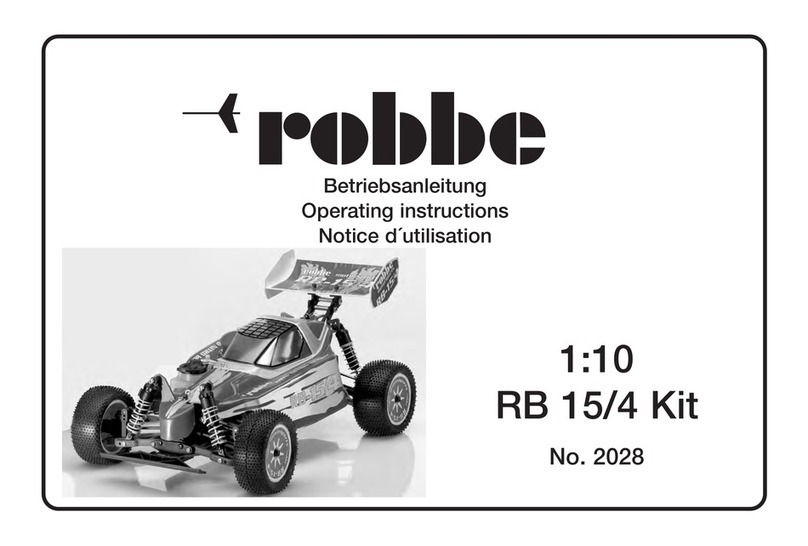
ROBBE
ROBBE RB 15/4 Kit User manual

ROBBE
ROBBE MAN F2000 Pritsche User manual
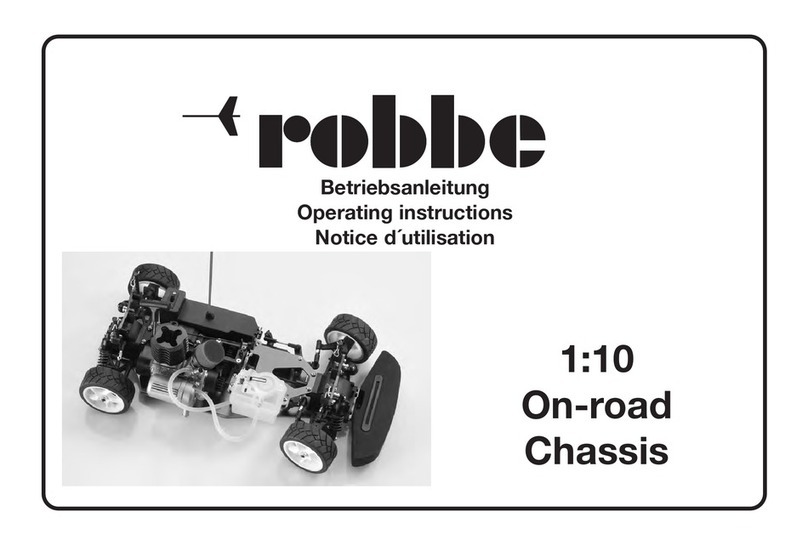
ROBBE
ROBBE S3003 User manual
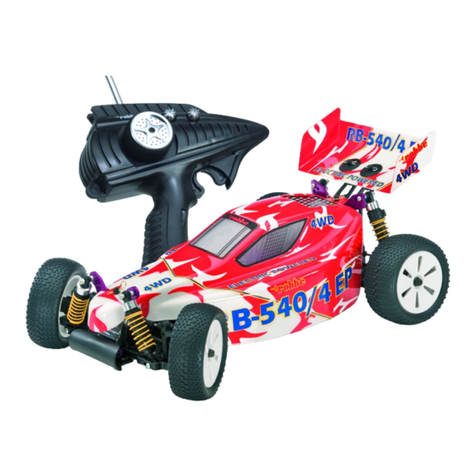
ROBBE
ROBBE Modellsport RB-540/4 EP User manual
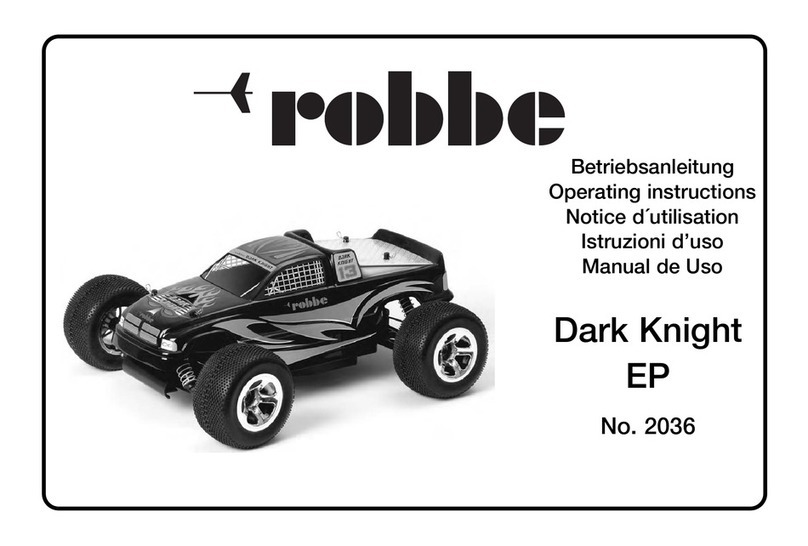
ROBBE
ROBBE Dark Knight EP 2036 User manual
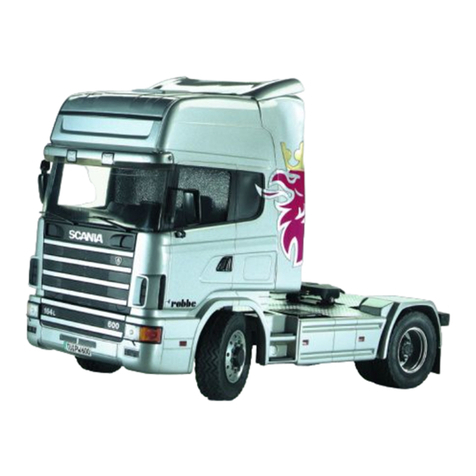
ROBBE
ROBBE 3374 User manual
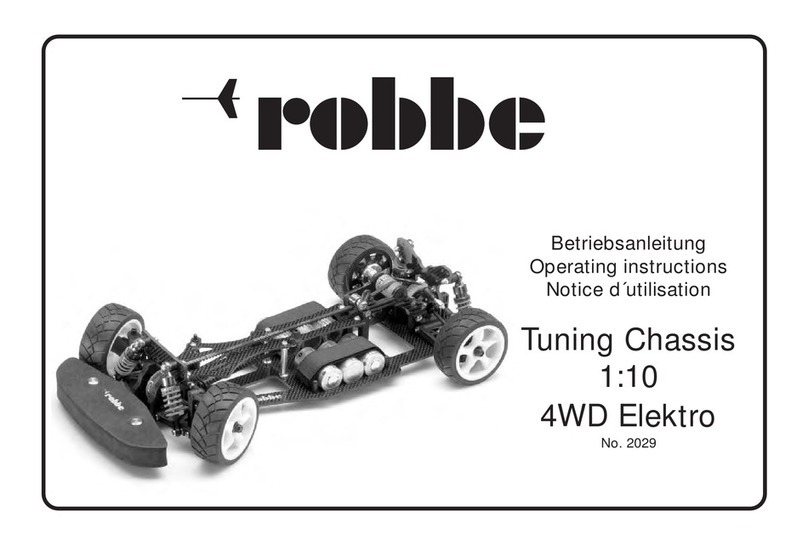
ROBBE
ROBBE Tunin chassis 1:10 4WD Elektro User manual
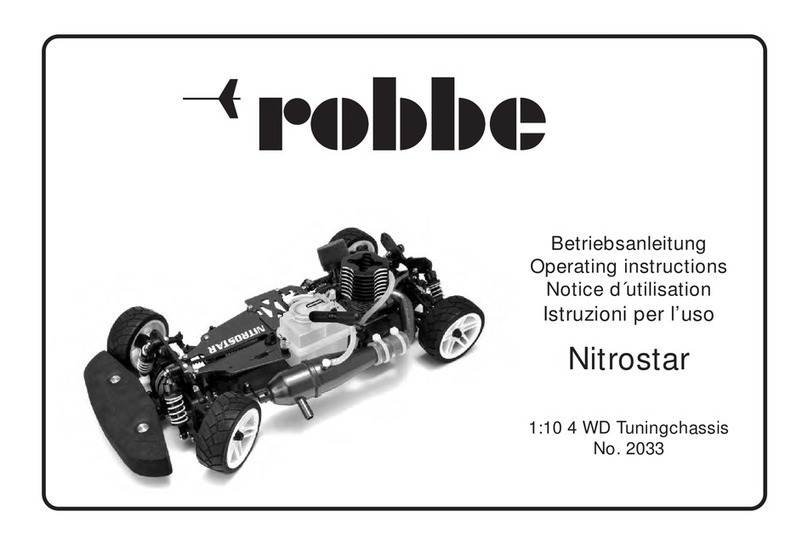
ROBBE
ROBBE 2033 User manual
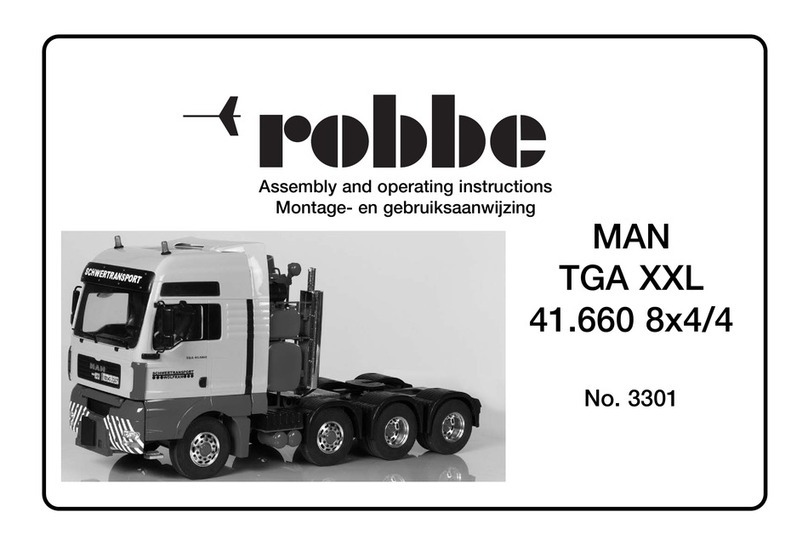
ROBBE
ROBBE MAN TGA XXL 8x4/4 User manual

